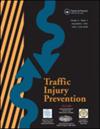自主紧急制动系统避撞性能的变化。
IF 1.6
3区 工程技术
Q3 PUBLIC, ENVIRONMENTAL & OCCUPATIONAL HEALTH
引用次数: 0
摘要
研究目的本研究量化了 2015 年以来日本交通事故中自动紧急制动(AEB)系统避免碰撞性能的变化:本研究使用了日本警察厅编制的日本交通事故数据。数据仅包括涉及人员伤亡的事故,不包括仅涉及财产损失的事故。我们的分析仅限于两辆四轮汽车之间的碰撞,并且只考虑我们可以确定主要当事方的汽车是否配备了自动紧急制动系统的碰撞。我们使用 2021 年和 2022 年的数据进行了泊松和负二项混合效应回归分析,以衡量 2015 年至 2020 年首次注册的配备了 AEB 系统的汽车与 2015 年首次注册的未配备 AEB 系统的汽车相比在避免碰撞方面的表现。避撞性能针对两种类型的车辆间碰撞进行了测量:追尾碰撞和右转碰撞。此外,还分别测量了标准、小型和轻型 3 种车型的追尾碰撞避撞性能:追尾碰撞事故的减少率随着首次注册年份的增加而增加,与 2015 年首次注册的未配备 AEB 系统的汽车相比,2020 年首次注册的配备 AEB 系统的汽车的追尾碰撞事故减少率为 69.2%(95% 置信区间 [CI]:67.0%-71.1%),这表明 AEB 系统在防止追尾碰撞事故方面的性能有了显著提高。在右转碰撞方面,2019年首次登记的配备AEB系统的汽车的右转碰撞率增至20.4%(95% CI为5.9%-32.6%)。然而,没有观察到明显的趋势:本研究采用独创的方法评估了 AEB 系统减少碰撞性能的时间序列。日本新车评估计划(JNCAP)自 2014 财年起将 AEB 在减少交通碰撞损害方面的有效性列为评估项目。这些结果可以证明 JNCAP 的有效性。本文章由计算机程序翻译,如有差异,请以英文原文为准。
Change in the collision avoidance performance of autonomous emergency braking systems
Objective
This study quantifies the change in collision avoidance performance of autonomous emergency braking (AEB) systems for traffic accidents in Japan since 2015.
Method
This study used data on Japanese traffic accidents compiled by Japan’s National Police Agency. The data included only accidents involving loss of or injury to human life; accidents involving only property damage were excluded. We restricted our analysis to collisions between two 4-wheel vehicles and considered only collisions for which we could determine whether the primary party’s car was equipped with an AEB system. Both Poisson and negative binomial mixed-effects regression analyses were conducted using the data for 2021 and 2022 to measure the collision avoidance performance of first registered cars in 2015 to 2020 equipped with AEB systems compared with cars without AEB systems first registered in 2015. Collision avoidance performance was measured for 2 types of intervehicle collisions: rear-end collisions and right-turn collisions. Collision avoidance performance for rear-end collisions was also measured for each of the 3 car types—Standard, small, and light cars.
Results
The collision reduction rate for rear-end collisions increases with the year of first registration and for cars equipped with AEB systems first registered in 2020 compared with non-AEB-equipped cars first registered in 2015 is 69.2% (95% confidence interval [CI] 67.0%–71.1%), indicating that the performance of AEB systems has dramatically improved in terms of preventing rear-end collisions. For right-turn collisions, the rate increased to 20.4% (95% CI 5.9%–32.6%) for cars equipped with AEB systems first registered in 2019. However, no clear trend is observed.
Conclusions
This study evaluated a time series of the collision reduction performance of AEB systems using an original methodology. Japan’s New Car Assessment Program (JNCAP) has included AEB’s effectiveness in reducing damage from traffic collisions as an evaluation item since FY2014. The results could demonstrate the effectiveness of JNCAP.
求助全文
通过发布文献求助,成功后即可免费获取论文全文。
去求助
来源期刊

Traffic Injury Prevention
PUBLIC, ENVIRONMENTAL & OCCUPATIONAL HEALTH-
CiteScore
3.60
自引率
10.00%
发文量
137
审稿时长
3 months
期刊介绍:
The purpose of Traffic Injury Prevention is to bridge the disciplines of medicine, engineering, public health and traffic safety in order to foster the science of traffic injury prevention. The archival journal focuses on research, interventions and evaluations within the areas of traffic safety, crash causation, injury prevention and treatment.
General topics within the journal''s scope are driver behavior, road infrastructure, emerging crash avoidance technologies, crash and injury epidemiology, alcohol and drugs, impact injury biomechanics, vehicle crashworthiness, occupant restraints, pedestrian safety, evaluation of interventions, economic consequences and emergency and clinical care with specific application to traffic injury prevention. The journal includes full length papers, review articles, case studies, brief technical notes and commentaries.
 求助内容:
求助内容: 应助结果提醒方式:
应助结果提醒方式:


